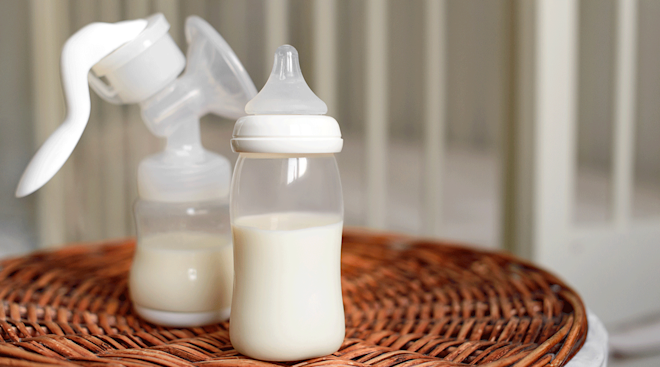How to Increase Milk Supply
It’s no secret that babies need a lot of calories and nutrition to fuel their growing bodies. If you’re breastfeeding, you’re probably paying close attention to your breast milk production—and you may even be concerned about low milk supply. In fact—because all parents want to ensure their child’s health and growth—you may be wondering how to increase milk supply. The good news? If you’re struggling with production, there are plenty of ways to increase milk supply. Keep reading to learn just how much milk you should be making, what causes low milk supply and how to increase your breast milk supply quickly and efficiently.
If you’re exclusively breastfeeding and baby is on target for healthy weight gain, your milk supply is likely a-okay, and there’s no need to increase breast milk production—even if baby seems famished or fussy. To maintain a good milk supply, most moms just need to breastfeed whenever baby is hungry, and your body will naturally take care of the rest.
“Breast milk supply is hormonally driven in the first few days following delivery,” says Stephanie Nguyen, RN, IBCLC, a board-certified lactation consultant and founder of Modern Milk, a breastfeeding clinic and prenatal-postnatal education center in Scottsdale, Arizona. “When you breastfeed, the nerves in your breasts alert your brain to release prolactin, the hormone behind breast milk production.”
While hormones are what initially spark milk production, supply-and-demand soon kicks into gear: Basically, the more you nurse, the more milk your body produces to keep up with baby’s needs. Seems pretty straightforward, right? But as any new mom can attest, that’s not always the case.
“New parents often have no clue how much their newborn should eat and tend to think they need more than they actually do,” says Katie Page, a certified nurse-midwife in Lynchburg, Virginia. This confusion makes many moms think they have low milk supply, when they’re actually doing just fine. Plus, unlike bottle-feeding parents, breastfeeding moms can’t see how much milk baby is really drinking, which just adds to supply stress. But the fact is, “90 percent of moms have the ability to make enough milk for their baby,” Nguyen says.
That said, low milk supply is a possibility for a number of reasons, including preterm birth, a poor latch or certain lifestyle choices.
It’s natural to panic if you think baby’s not getting enough milk, and trust us, we know that panic doesn’t mix well with those wild postpartum hormones! But take a deep breath and relax, because although low milk supply may seem like a mystery, it’s one you can usually solve. Here are the most common causes of low milk supply:
Not feeding enough
In the first few weeks following delivery, babies can be super sleepy and sometimes snooze right through feedings. If they’re packing on the pounds regardless, by all means, let a sleeping baby lie. But if not, wake your snoozer up to nurse. How? “Unswaddle them! Swaddling suppresses hunger cues and normal waking cycles,” says Barbara Cohen, IBCLC, RLC, LLLL, a board-certified lactation consultant in New York City. “Take off any hats, which keep them too warm, and remove mittens so they can suck on those little hands they’ve been sucking on for months before they’re even born.” These techniques should arouse baby enough to pack in all those daily recommended feedings. For the first few weeks, you should be breastfeeding eight to 12 times a day, which shakes out to about every two or three hours.
Supplementing with a bottle
Generally speaking, your body is built to produce as much milk as baby needs—so when baby breastfeeds often, your body understands there’s a high demand for milk and ramps up production to meet it. If you’re introducing bottles instead of nursing at the breast, still keep pumping while baby bottle-feeds. (More on this below.) Otherwise, if you skip the session entirely, your body will be tricked into thinking baby needs less milk and start to shrink the supply.
An ineffective latch
Sometimes, the problem isn’t with how often baby is breastfeeding but how they’re feeding at the breast. “A poor latch can be detrimental to the entire breastfeeding process,” Nguyen says. “Baby removes less milk, so mom produces less milk.” When a baby has a good latch, more milk comes out, and more milk is made.
Using a pacifier
“If baby is using a pacifier throughout the day, it can satisfy their need to [suck] and they may not show hunger cues,” Nguyen says. If you’re planning on using a pacifier, wait until baby is 3 or 4 weeks old and your milk supply is well established before introducing it.
Drinking alcohol or smoking
Both of these things can decrease milk supply. Smoking can also slow your let-down reflex, making it harder for baby to nurse. If you’re breastfeeding, avoid these substances.
Baby born prematurely
Premature babies are sometimes too small and weak to breastfeed, so you may have to try pumping to increase milk supply. “If baby was born prematurely—or was separated from you after birth—it’s important to begin pumping right away to establish a good milk supply,” Nguyen says. If you don’t, your milk production can take a big hit.
Health issues or medications
It’s common for a mom’s breast milk supply to take a (temporary) dip if she’s sick with a cold or the flu. But other health conditions, like polycystic ovary syndrome or thyroid issues, can have a more lasting impact on breast milk production, as can prior breast surgery. Certain medications can also affect milk supply, like a combined contraceptive pill or a decongestant. Before taking any medications that may impact milk supply, be sure to consult your doctor first.
Advanced maternal age
Women over the age of 35 who give birth for the first time will much more likely need to find ways to increase milk supply than their younger counterparts. “Any mom that’s considered to be of advanced maternal age should get the best stimulation early on to have the best chance of breastfeeding,” says Nancy Clark, BS, IBCLC-RN, a lactation consultant with Northern Virginia Lactation Consultants. “Do it from the start, and talk to a lactation consultant during pregnancy. It’s important to maximize milk supply from the very beginning.”
Rest assured that a decrease in breast milk supply is not a permanent problem. There are a lot of natural ways to increase milk supply and stimulate your milk ducts so they produce more breast milk. And the really good news is that most of these strategies are pretty simple to incorporate into your day-to-day routine. If you feel like your supply is low, read on for how to increase milk supply.
Keep on breastfeeding
Suffice it to say: supply meets demand. And so the more you breastfeed, the more milk you’ll produce. “Milk production really doesn’t stop. It’s a continuous process,” says Kelly Durbin, IBCLC, author of Protecting Your Potential for Breastfeeding. “The best strategy for increasing milk production is to remove more milk from the breast,” she adds. So if you feel like you’re efforts are fruitless, just know that you’ll ultimately be rewarded by going through the motions.
Pump to increase milk supply
Pumping to increase milk supply can be done by using your pump (hospital-grade double pumps work best) for every missed feeding or anytime baby gets a supplemental bottle of breast milk or formula. It’s also a good idea to express any leftover milk after each feed. Another method, if you’re wondering how to increase milk supply when pumping, is power pumping, Page says. “For an hour each day, pump 20 minutes, rest 10 minutes, pump 10, rest 10, pump 10. This can be done for a few days and works by signaling the body to make more.”
Drink plenty of water
You should also drink a ton of water to keep your supply in good shape, Page says. It makes sense that your body can’t produce ample milk if you’re dehydrated, so try downing an eight-ounce glass each time you breastfeed, plus a few more throughout the day.
Medication to increase milk supply
If you’re truly struggling to provide baby with enough milk, you may have heard of two controversial drugs that can increase milk supply. New moms should be aware that using medication to increase milk supply should be explored only as a last resort, since neither drug has been approved by the FDA for increasing milk supply. A doctor or lactation consultant should always be consulted to ensure there truly is a supply issue, and if there is, all other avenues should be exhausted first. Here, more information about both drugs.
- Reglan. This is a drug used for digestive issues and can be effective as a galactagogue. “Reglan can be very effective and safe if taken in the short term,” de Franco says. He notes the course should be two weeks or less, but some research notes it may take up to 3 weeks to work. As always, consult with your doctor first. New moms should take caution when considering this drug, since severe depression and fatigue are two of the more common side effects—both of which can make the already tough postpartum period even more difficult.
- Domperidone. Originally used to ease nausea and vomiting, domperidone was also used as a medication to increase milk supply until it was banned for sale in the US by the FDA due to cardiac risks. Many researchers are actively trying to get it back, though—according to studies it seems to have fewer side effects than Reglan and is excreted in breast milk at a drastically lower percentage than Reglan, making it safer for baby too.
Eat foods to help with breast milk supply
Wondering if you can eat certain foods to increase milk supply? Actually, it’s possible! There are several foods (and drinks) that have anecdotally been said to help get your milk flowing. And of course, these foods can be used in addition to other ways to increase milk supply, like pumping and taking supplements (just talk to your doctor first!). Here are some of the best foods to increase milk supply:
- Oatmeal. You can’t go wrong with oatmeal, since it’s both delicious and filling. “Quick oats, regular oats, steel-cut oats—oatmeal in all forms is said to increase milk supply,” O’Connor says. “People of some cultures even blend oats with water, then strain the oats from the water and use the remaining milky water as a supply-boosting drink.”
- Flaxseed. Thanks to their omega content, flax seeds are among the best ways to increase milk supply.
- Pumpkin. Fall might be the season of milk production for you, as research has show that consumption of pumpkin is correlated with an uptick in supply.
- Fennel. Eat it raw, sautéed or roasted, and reap the rewards. Fennel has been shown to increase milk supply.
Additionally, Mayo Clinic advises breastfeeding moms fuel milk production with protein-rich foods, like lean meat, eggs, dairy, beans, lentils and seafood low in mercury.
Consider herbs to increase milk supply
Herbs have been used for medicinal purposes throughout history. Curious about how to increase breast milk production this way? Several herbs are considered to be effective galactagogues, and many moms have seen tangible results using some of these herbs to increase milk supply. Many of these are the active ingredients in lactation cookies, teas and supplements. “Lactation teas tend to contain fennel, borage, fenugreek, blessed thistle and other digestives.” Better yet, you can try combining the tea with some lactation cookies for a yummy snack that may help ramp up your supply.
- Fenugreek. “Fenugreek is probably the most common of the herbs to increase milk supply, and works well for many moms,” Nguyen says. “There are also supplement blends that contain multiple supplements in one pill. I prefer these because you may respond to one supplement and not another, so it’s best to try multiple supplements at once.”
- Blessed thistle. This is another galactagogic herb that lactation consultants often recommend in tandem with Fenugreek. It’s often found in the supplement blend pills and in lactation tea as well.
- Alfalfa. Alfalfa has long been used by nursing mothers as an effective herb for increasing milk supply, and it boasts lots of other health benefits too. Alfalfa can be consumed in its plant form, in a pill or even as a tea.
- Oat straw. You may not have heard of this one before, even if you were familiar with the other herbs on this list. But, according to Cohen, “oat straw is a very helpful herb that boosts milk supply and is very calming due to it being rich in B vitamins.”
- Brewer’s yeast. Typically sold in powdered form and admittedly not the tastiest ingredient on the planet, brewer’s yeast is most often used to make beer and wine. However, it has been considered effective at increasing milk supply, and is often one of the main ingredients in those super-popular lactation cookies. It’s packed with iron, protein and B vitamins and is generally considered safe to consume.
Note that it’s important to talk to your physician before taking any herbs or supplements to increase milk supply. And if you’re given the go-ahead, know that once you reach a point where your supply is where you want it, you should stop taking the pills or products.
Frequently Asked Questions
How long does it take to increase milk supply?
Wondering how long it’ll take to boost your milk supply? Unfortunately, there’s no clear answer. “It’s impossible to know how long it’ll take to increase milk supply,” Cohen says. “It depends on why the supply was low to begin with.” But know this: Most methods you can try will either work relatively quickly, or they won’t at all. In other words, you don’t have to take fenugreek for months hoping for results—if it’s going to work, you’ll likely see an increase in milk supply soon. Remember that the best way to increase milk supply is to relax, eat healthy food, hydrate and nurse baby often. But if you still find yourself struggling, don’t hesitate to reach out to your doctor or a lactation consultant. They can help answer questions and provide solutions to get both you and baby back on track.
How do you know if you have a low supply of breast milk?
Keep your eyes peeled for these common signs of low milk supply:
- Stalled weight gain. Babies normally lose up to 10 percent of their birth weight in the first few days, but they should regain that by the time they hit the two-week mark. If baby struggles to put those pounds back on, low supply may be an issue. “It’s important to know that newborn weight charts are based on standards set from formula-fed babies, who may gain weight faster than breastfed babies because the fat content in formula is higher and constant at every feeding,” Page says. “The most important thing is that babies are continuing to grow, even if slowly.” On average, a well-fed baby gains four to seven ounces a week.
- Fewer dirty diapers. During baby’s first several days, they should wet the same number of diapers as their age in days. So a 2-day-old will dirty two diapers. Starting around day 5, “a baby who is well fed should have at least two to five dirty diapers with yellow poop and at least four to six wet diapers with clear urine,” says Leigh Anne O’Connor, IBCLC, BA, LLL, a board-certified lactation consultant in New York City. Take a peek inside: If the urine is light yellow or colorless and their poop is big, seedy and mustard-colored, they’re likely getting enough milk.
- Decrease in baby activity. “Babies who aren’t getting enough to eat are lethargic,” Page says. “They may not wake as often or be as active when they wake. They also look thin, losing that chubby baby look as their body uses the energy from their stored fat to power the brain, adrenal glands and more.” Trust your parental instincts on this one.
Can beer increase milk supply?
Ready to pour yourself a Guinness? The American Academy of Pediatrics (AAP) says this is a myth. “There’s no scientific evidence that beer can increase milk supply. However, anecdotal evidence shows that some people do find they get a boost from beer,” says Durbin. “You’ll want to use a hefty dose of caution with anecdotal evidence because people may simply be perceiving an increase in milk supply when there really isn't one—or they may be trying several things at one time to increase milk production. It’d be hard to say which things helped the most.”
Can essential oils increase milk supply?
Many natural living sites tout the use of essential oils to increase milk supply—but the jury’s out on whether they’re effective or not. “There’s no research to back up the use of essential oils to increase milk supply,” says Jennifer de Franco, RN, IBCLC, lactation consultant with Premier Lactation Services in Northern Virginia. “No one in the field is really talking about them.”
Clark agrees, saying, “There are no essential oils that would increase milk supply. There are some that would make mom more relaxed, but you have to be incredibly careful using essential oils during pregnancy and lactation because some are unsafe for mother and baby.”
Please note: The Bump and the materials and information it contains are not intended to, and do not constitute, medical or other health advice or diagnosis and should not be used as such. You should always consult with a qualified physician or health professional about your specific circumstances.
Plus, more from The Bump:
Nancy Clark, BS, IBCLC-RN, is a lactation consultant and educator with Northern Virginia Lactation Consultants, as well as a certified LaMaze Childbirth Educator. She has over 30 years of experience and presently serves as a mentor for the International Board of Lactation Consultant Examiners (IBCLE). She earned her bachelor of science degree from Georgetown University in 1974.
Barbara Cohen, IBCLC, RLC, is a board-certified lactation consultant in New York City with over two decades of experience as a lactation consultant, volunteer La Leche League Leader and postpartum doula.
Jennifer de Franco, RN, IBCLC, is a lactation consultant with Premier Lactation Services in Northern Virginia. She earned her nursing degree in 1999 from Shenandoah University and worked as a NICU nurse at Prince William Hospital prior to joining Premier Lactation Services.
Kelly Durbin, IBCLC, is a lactation consultant and the author of Protecting Your Potential for Breastfeeding.
Stephanie Nguyen, RN, IBCLC, is a board-certified lactation consultant and founder of Modern Milk, a breastfeeding clinic and prenatal-postnatal education center in Scottsdale, Arizona. Previously she has also worked as a postpartum, labor and delivery nurse. She received her master of science degree in nursing from the University of Cincinnati.
Leigh Anne O’Connor, IBCLC, BA, is a board-certified lactation consultant based in New York City. She has over 20 years of experience and has previously served as the president on the Board of the New York Lactation Consultant Association. She earned her bachelor of arts in communication from UNC-Greensboro, was accredited as a La Leche League Leader in 1997 and was board certified as an IBCLC in 2002.
Katie Page, is a certified nurse-midwife based in Lynchburg, Virginia. She has over a decade of experience, earned master’s of science in nursing from Vanderbilt University School of Nursing and is certified by the American Midwifery Certification Board.
USDA WIC Breastfeeding Support, How Much Milk Your Baby Needs
USDA WIC Breastfeeding Support, Low Milk Supply
National Library of Medicine, Brewer’s Yeast, September 2023
American Pregnancy Association, Do I Have a Low Milk Supply?
American Academy of Pediatrics (AAP), Alcohol and Breast Milk
Nemours KidsHealth, Your Newborn’s Growth, October 2018
Centers for Disease Control and Prevention, Breastfeeding as the Norm for Infant Feeding, February 2022
University of Utah Health, How to Ensure Your Newborn is Getting Enough to Eat, March 2017
National Library of Medicine, Physiology, Lactation, July 2023
La Leche League International, Is My Baby Getting Enough Milk?
American Journal of Human Biology, The Impact of Swaddling Upon Breastfeeding: A Critical Review, February 2023
Nemours KidsHealth, Breastfeeding FAQs: How Much and How Often, November 2019
Stanford Medicine Children’s Health, Problems With Latching On or Sucking
Stanford Medicine Children’s Health, How to Use a Pacifier
International Journal of Environmental Research and Public Health, Mother’s Own Milk Feeding in Preterm Newborns Admitted to Neonatal Intensive Care Unit or Special-Care Nursery: Obstacles, Intervention, Risk Calculation, April 2021
Journal of Human Lactation, Traditional Galactagogue Foods and Their Connection to Human Milk Volume in Thai Breastfeeding Mothers, August 2017
National Library of Medicine, Flaxseed, May 2023
UT Southwestern Medical Center, 4 Factors That Can Decrease Breast Milk Supply—And How to Replenish It, May 2022
La Leche League International, Breastfeeding With Polycystic Ovarian Syndrome (PCOS)
La Leche League International, Breastfeeding and Thyroidism
Centers for Disease Control and Prevention, Breast Surgery, July 2023
National Library of Medicine, Contraceptives, Oral, Combined, September 2023
Mayo Clinic, Breastfeeding and Medications: What’s Safe?, August 2022
Preventative Medicine Reports, Combined effects of maternal age and parity on successful initiation of exclusive breastfeeding, June 2016
Plus One, Use and experiences of galactagogues while breastfeeding among Australian women, July 2021
USDA FoodData Central, Brewer’s Yeast Powder, July 2020
National Library of Medicine, Fennel, March 2023
National Library of Medicine, Barley, September 2022
Phytotherapy Research, Effectiveness of Fenugreeks as a Galactagogue: A Network Meta-Analysis, March 2018
National Library of Medicine, Lavender, September 2023
National Library of Medicine, Metoclopramide, October 2023
Cleveland Clinic, Metoclopramide Tablets, 2023
U.S. Food & Drug Administration, How to Request Domperidone for Expanded Access Use, February 2021
Mayo Clinic, Domperidone (Oral Route), November 2023
Mayo Clinic, Breast Feeding Nutrition: Tips for Moms, April 2022
Clinical Lactation, Domperidone Versus Metoclopramide: Self-Reported Side Effects in a Large Sample of Breastfeeding Mothers Who Used These Medications to Increase Milk Production, January 2018
Veterinary Medicine Interational, Pharmacological Overview of Galactogogues, 2014
Learn how we ensure the accuracy of our content through our editorial and medical review process.
Navigate forward to interact with the calendar and select a date. Press the question mark key to get the keyboard shortcuts for changing dates.




















































